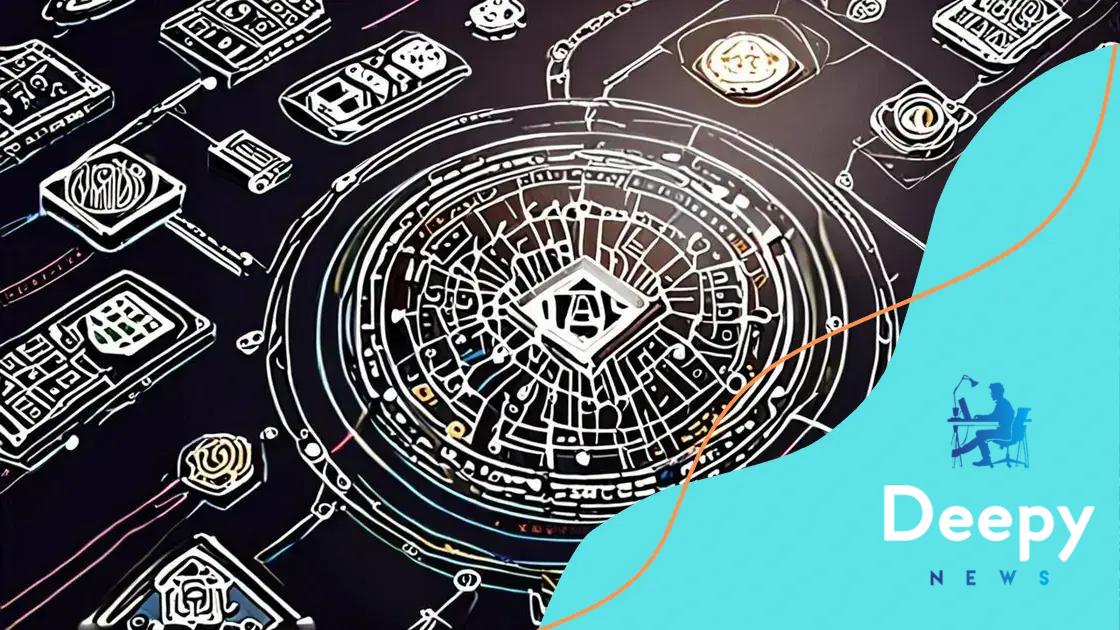The future of decentralized finance (DeFi) platforms

The future of decentralized finance (DeFi) platforms presents significant opportunities for accessibility, lower costs, and innovative financial products, while also posing risks such as smart contract vulnerabilities and market volatility.
The future of decentralized finance (DeFi) platforms is an exciting journey that many are just beginning to explore. Imagine a world where financial services are accessible to everyone, regardless of their background. This article delves into how DeFi is changing the landscape of finance as we know it.
Understanding decentralized finance: A new frontier
Decentralized finance, commonly known as DeFi, has been making waves in the financial sector. It’s revolutionizing how we think about money and financial services. DeFi leverages blockchain technology to eliminate intermediaries, creating a more open and accessible financial system.
What is DeFi?
DeFi refers to a suite of financial services that are built on top of blockchain networks. Unlike traditional finance, where banks act as intermediaries, DeFi platforms allow users to trade, lend, and borrow directly with one another. This revolutionary model offers numerous benefits.
- Accessibility: Everyone with an internet connection can use DeFi services.
- Lower Fees: With no intermediaries, transaction fees are often lower.
- Transparency: All transactions are recorded on the blockchain, ensuring a transparent system.
- Ownership: Users retain their assets, unlike in traditional finance.
One key aspect of decentralized finance is its reliance on smart contracts. These self-executing contracts are programmed to enforce the terms automatically, without the need for human intervention. This enhances security and reduces the potential for fraud.
How DeFi Works
DeFi platforms typically operate on Ethereum or other blockchain networks. Users interact with applications (dApps) that facilitate lending, borrowing, and trading cryptocurrencies or tokens. When engaging in transactions, users must be familiar with wallet management and the overall mechanics of blockchain technology.
Moreover, many DeFi applications provide users with the opportunity to earn interest on their assets. By depositing assets in liquidity pools, users can lend to others and receive a portion of the transaction fees in return. This creates an ecosystem where users can generate income on their holdings.
Ultimately, understanding decentralized finance is essential for anyone looking to navigate the future landscape of money and investment. As more people adopt these technologies, we are likely to see continued growth and innovation in this exciting sector.
Key benefits of DeFi platforms
DeFi platforms offer a range of advantages that are reshaping the financial landscape. Users can access financial services without traditional banking limitations. This accessibility is one of the core strengths of decentralized finance.
Financial Inclusion
With DeFi, anyone can participate. This is especially important for individuals in underserved areas. Many people lack access to banks, yet they can engage with DeFi platforms using just a smartphone.
- No banking requirement: Users don’t need a traditional bank account.
- Global access: Anyone around the world can use DeFi.
- 24/7 availability: Services are always available without restrictions.
The transparency inherent in DeFi platforms is another significant benefit. All transactions are recorded on the blockchain, ensuring that users can verify the legitimacy of their dealings at any time.
Lower Costs
By eliminating intermediaries, DeFi reduces fees associated with traditional financial transactions. This means that users can save money on transfers and trades. They have direct control over their assets, which leads to cost efficiency.
Moreover, DeFi platforms often offer competitive interest rates for lending and borrowing. Users can earn interest on their crypto holdings while accessing loans without the traditional credit checks.
Additionally, the innovative nature of decentralized finance allows for new financial products and instruments. From yield farming to liquidity pools, users can explore various ways to grow their assets.
As more people understand the benefits of DeFi, adoption is likely to rise. This shift towards a more decentralized financial system presents unique opportunities for innovation and growth.
How DeFi is reshaping traditional finance

Decentralized finance (DeFi) is fundamentally changing the way we view traditional finance. By leveraging blockchain technology, DeFi eliminates the need for intermediaries, making financial services more accessible and efficient.
Eliminating Middlemen
With DeFi, users no longer rely on banks to execute transactions. This shift is significant because it reduces costs and minimizes delays. Users can trade, lend, and borrow directly, streamlining processes.
- Reduced transaction fees: Without banks, costs are often lower.
- Faster transactions: DeFi platforms often process transactions in minutes.
- 24/7 access: Financial services are available anytime, anywhere.
This shift toward a more open financial system means that individuals regain control over their finances. With DeFi, anyone can manage their assets without the constraints set by traditional banks.
Innovative Financial Products
Furthermore, DeFi has introduced new financial products that were not previously possible. Innovations like liquidity pools and yield farming allow users to earn interest on their assets. This is reshaping investment strategies and providing new ways to generate passive income.
The concept of tokenization is also making waves, where real-world assets are represented as digital tokens on the blockchain. This process increases liquidity and makes it easier to trade these assets.
As more people explore the benefits of DeFi, traditional banks may be forced to adapt. Many financial institutions are beginning to recognize the advantages of incorporating blockchain technology into their services.
The evolving landscape suggests that a hybrid approach may emerge, allowing traditional finance to coexist with decentralized systems. This change could enhance user experience and efficiency across the board, making financial interactions simpler and more transparent.
Navigating risks in decentralized finance
While decentralized finance (DeFi) offers many advantages, it also comes with certain risks that users should be aware of. Understanding these risks is essential for anyone looking to participate in the DeFi ecosystem.
Smart Contract Vulnerabilities
One of the primary risks in DeFi is related to smart contracts. These are self-executing contracts with the terms directly written into code. If there are flaws or bugs in the code, it can lead to significant financial losses for users.
- Audits are critical to ensure the security of smart contracts.
- Users should consider the reputation of the platform before investing.
- Always keep funds in reputable wallets to minimize exposure to hacks.
Another important aspect to consider is market volatility. The crypto market is known for its rapid price changes, which can affect investments massively. Users need to be prepared for the possibility of losing money due to this volatility.
Regulatory Risks
The regulatory environment for DeFi is still evolving. Governments around the world are considering how to regulate these platforms. Changes in regulations can impact the operations of DeFi projects and may introduce compliance requirements.
Furthermore, using decentralized exchanges (DEXs) can pose liquidity risks. Some tokens may have low trading volumes, making it difficult to sell them quickly without affecting their price. As a result, users should always research the liquidity of the assets they intend to trade.
Phishing attacks are another significant threat in the DeFi space. Scammers often pose as legitimate platforms to trick users into revealing their private keys. Users must stay vigilant and ensure they only use official websites and apps.
Ultimately, while navigating risks in decentralized finance can be challenging, being informed and cautious can help mitigate these dangers and lead to a more secure experience in the DeFi landscape.
Real-world examples of successful DeFi applications
Many successful applications demonstrate how decentralized finance (DeFi) is transforming the financial landscape. These examples highlight the innovative ways DeFi platforms provide value to users.
Aave
Aave is a popular lending and borrowing platform in the DeFi space. Users can lend their cryptocurrencies to others and earn interest on them. The platform operates on the Ethereum blockchain and enables users to borrow funds by providing collateral.
- Flash loans: Users can borrow instantly without collateral.
- Stable and variable interest rates based on market demand.
- Ability to switch between borrowing styles for flexibility.
This flexibility attracts a wide range of users, from casual investors to professional traders.
Uniswap
Uniswap is one of the largest decentralized exchanges (DEXs) that allows users to trade cryptocurrencies directly without intermediaries. It uses an automated market-making system, which provides liquidity through user-contributed pools.
Users can earn rewards by supplying liquidity, which incentivizes participation in the platform. Some key features of Uniswap include:
- Decentralized trading without any central authority.
- User-friendly interface for easy asset swaps.
- Efficient price discovery through liquidity pools.
Uniswap has gained widespread adoption due to its straightforward approach to trading.
Compound
Compound is another significant DeFi application that allows users to lend and borrow cryptocurrencies. It operates similarly to Aave, enabling users to earn interest on their assets while borrowing against them. Compound uses a unique algorithm to determine interest rates based on supply and demand.
This platform has made earning passive income easier for many crypto investors. Users can:
- Deposit various cryptocurrencies to earn interest.
- Borrow against their crypto holdings efficiently.
- Monitor rates in real-time for informed decisions.
These real-world examples of successful DeFi applications demonstrate the potential of decentralized finance. They show how these platforms offer innovative solutions that traditional finance struggles to match.
Conclusion: In summary, decentralized finance (DeFi) is changing how we interact with financial services. By eliminating intermediaries, DeFi platforms like Aave, Uniswap, and Compound are making financial transactions more accessible and efficient. While there are risks to consider, such as smart contract vulnerabilities and market volatility, the benefits of DeFi are driving more people to explore this innovative sector. As DeFi continues to evolve, it paves the way for a more inclusive financial future for everyone.
FAQ – Frequently Asked Questions about Decentralized Finance (DeFi)
What is decentralized finance (DeFi)?
Decentralized finance (DeFi) refers to financial services that operate on blockchain technology, allowing users to trade, lend, and borrow without intermediaries.
What are the benefits of using DeFi platforms?
DeFi platforms offer benefits such as lower transaction costs, accessibility, innovative financial products, and the ability to earn interest on crypto assets.
What risks should users be aware of in DeFi?
Users should be mindful of risks like smart contract vulnerabilities, market volatility, regulatory changes, and phishing attacks.
Can anyone access DeFi services?
Yes, anyone with an internet connection can access DeFi services, making it a more inclusive financial option than traditional banking.






